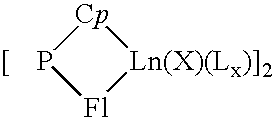Catalytic system for obtaining conjugated diene/monoolefin copolymers and these copolymers
a catalytic system and diene technology, applied in the direction of catalyst activation/preparation, physical/chemical process catalysts, chemical/physical processes, etc., can solve the problems of reduced molecular mass of copolymers obtained, deactivation of catalytic systems, and difficulty in copolymerization of conjugated diene and monoolefin
- Summary
- Abstract
- Description
- Claims
- Application Information
AI Technical Summary
Benefits of technology
Problems solved by technology
Method used
Image
Examples
example 1
Synthesis of the Organometallic Complex [Me2Si(C5H4)(C13H8)]NdCl(OC4H8)x
Synthesis of the Ligand Me2Si(C5H5)(C13H9)
[0096] The ligand Me2Si(C5H4)(C13H9), where Me denotes a methyl group, was synthesized according to an operating method described in the literature (Alt et al J. Organomet. Chem. 1996, 509, pp. 63-71).
Synthesis of the Salt [Me2Si(C5H4)(C13H8)]Li2(OC4H8)2
[0097] 12.1 ml of 1.6 M BuLi are added at ambient temperature to a solution of 2.8 g of the ligand Me2Si(C5H5)(C13H9) in 150 ml of THF. The solution is stirred for 4 h, then the THF is evaporated. The residue is dried in a vacuum then washed while cold with two 50 ml portions of heptane. A yellow solid is isolated. 1H NMR analysis of this solid was performed with a “BRUKER 300 MHz” spectrometer in the range THF-d8: δ(chemical shift in ppm)=
[0098] 7.85 (d, J 8 Hz, 2H, Fl),
[0099] 7.77 (d, J 8 Hz, 2H, Fl),
[0100] 6.79 (dd, J 8 Hz and 7 Hz, 2H, Fl),
[0101] 6.44 (dd, J 8 Hz and 7 Hz, 2H, Fl),
[0102] 6.15 (m, 2H, Cp),
[010...
example 2
Copolymerization of Butadiene and Ethylene by Means of the Organometallic Complex of Example 1 and Various Co-Catalysts
[0109] Three tests according to the invention of the copolymerization of ethylene and butadiene were performed according to the operating method described below, together with a “control” test of the homopolymerization of ethylene.
[0110] A solution composed of 300 ml of toluene, a specific quantity xc (mg) of the organometallic complex of the formula [Me2Si(C5H4)(C13H8)]NdCl(OC4H8)x prepared in Example 1 and of a co-catalyst according to the invention and then a mixture of ethylene and butadiene with a molar fraction y (%) of butadiene were introduced in succession into a reactor under an argon atmosphere. The internal pressure of the reactor was maintained at 4 bar when the fraction y of butadiene so permits. The temperature of the polymerization reactor was maintained at 80° C. for the polymerization.
[0111] After a reaction time t (min.), polymerization is term...
example 3
Copolymerization of Butadiene and Octene by Means of the Organometallic Complex of Example 1 and Various Co-Catalysts
PUM
 Login to View More
Login to View More Abstract
Description
Claims
Application Information
 Login to View More
Login to View More - R&D
- Intellectual Property
- Life Sciences
- Materials
- Tech Scout
- Unparalleled Data Quality
- Higher Quality Content
- 60% Fewer Hallucinations
Browse by: Latest US Patents, China's latest patents, Technical Efficacy Thesaurus, Application Domain, Technology Topic, Popular Technical Reports.
© 2025 PatSnap. All rights reserved.Legal|Privacy policy|Modern Slavery Act Transparency Statement|Sitemap|About US| Contact US: help@patsnap.com



